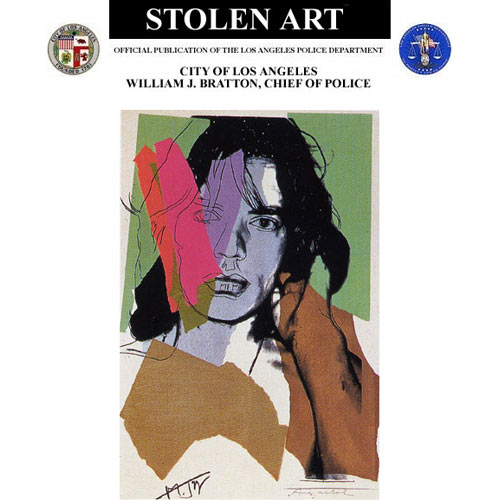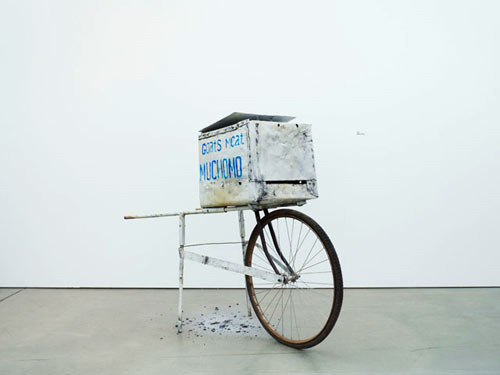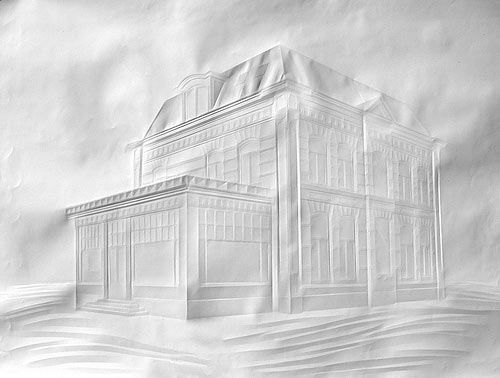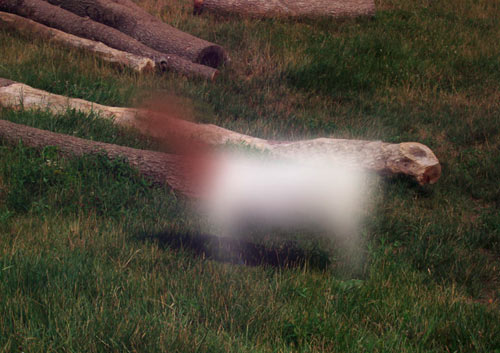LAPD stolen art poster show
Stolen art in the Los Angeles area results in some unorthodox art posters. Here’s a missing Warhol print of Mick Jagger:

Looks like something Warhol himself might have come up with.



This site is made possible by member support. ❤️
Big thanks to Arcustech for hosting the site and offering amazing tech support.
When you buy through links on kottke.org, I may earn an affiliate commission. Thanks for supporting the site!
kottke.org. home of fine hypertext products since 1998.
Stolen art in the Los Angeles area results in some unorthodox art posters. Here’s a missing Warhol print of Mick Jagger:

Looks like something Warhol himself might have come up with.
That’s the name of Ohio-based artist Richard Whitehurst’s latest work.
The artist plans to place himself in a room, the only entrance or exit being a 22 ft long plywood tunnel constructed by Whitehurst himself. Then he says that for the duration of the gallery’s opening (from 7:00 p.m. to midnight) he will rape anyone who travels through the tunnel into that room.
Whitehurst prototyped the idea with a previous project called The Punch-You-In-The-Face Tunnel.
As it turns out, I ended up breaking the nose of the third person to crawl through the tunnel, an aspiring model. She went to the hospital and eventually sued me. Her modeling career was put on hold. The civil case was long and drawn out and the matter still hasn’t been resolved. To this day she still has unpaid medical bills. The point of this long aside is that all this took place two years ago, and I’m still having an impact on this young lady’s life, something not many other artists could claim about their work.
Rape seemed like the next logical step.
Me? I would have built The Tickle Tunnel. I guess that’s why I’m not an artist. (via mxml)
Update: Oh, hell, it’s fake. (thx, dozens of people who aren’t saps like I am)
In 2001, Tim Hawkinson created Uberorgan for the gallery at MassMOCA.
Several bus-size biomorphic balloons, each with its horn tuned to a different note in the octave, make up a walk-in self-playing organ. A 200 foot-long scroll of dots and dashes encodes a musical score of old hymns, pop classics, and improvisational ditties. This score is deciphered by the organ’s brain - a bank of light sensitive switches - and then reinterpreted by a series of switches and relays that translate the original patterns into non-repeating variations of the score.
Part sculpture, part giant musical instrument, Hawkinson’s installation was a loose interpretation of the human body’s organ systems. Uberorgan conducted itself for five minutes every hour, on the hour. The exhibition traveled from MassMOCA to the Getty Center in Los Angeles, where it graced the museum’s entrance hall during the exhibit of Hawkinson’s work called Zoopsia, a name that means “visual hallucinations of animals.”
You can hear a minute long sample of the Uberorgan on the Getty Center website. To me it sounds like a duet between a three-year-old jamming out on a bass saxophone and an elephant in a good mood.
Update: Tim Hawkinson and the Uberorgan are featured the Art:21 episode,”Time.” Seeing and hearing the piece, even on the small screen, is impressive, and Hawkinson explains how he came about creating such a voluminous, volume-driven work of art. (thx, cliff)
The art of Sandhi Schimmel Gold is junk. The artist uses junk mail to create semi-mosaic’ed handmade portraits. Using advertising ephemera and all kinds of textures and colors, she’s constructed representations of Frank Sinatra, Kurt Vonnegut, Jackie O, and Audrey Hepburn, among others. She combines painting with collage to render faces that are unbelievably detailed and realistic. If you want to see what Schimmel would do with your visage you can commission a piece. I’d like to see my neighbor’s mug constructed from of all of his Cabela’s catalogs that find themselves in my mailbox.
An interesting article in The Brooklyn Rail debates the value of commercialism versus criticism in the art world. Riffing off of an essay called “Frivolity and Unction” from Dave Hickey’s book, Air Guitar, writer Shane McAdams opines that art doesn’t have to be “important” to be good:
“Art” can be unimportant and still allow for the experience of a work of art to be life-changing. I value the memories I have of listening to baseball games on my grandparents’ porch, but Baseball, as a concept, remains entirely unimportant. Such concepts as baseball, art, and Hickey’s example of rock and roll, are wholly unimportant except for the experiences they foster and the history to which they contribute.
Kasey McMahon decided to combine an interest in taxidermy with her PC. Fearing that the natural world is being replaced by technology, the artist installed a working computer inside of an idle beaver. First, she crafted a computer from the motherboard up, tested it, then hollowed out a stuffed beaver and molded the two together using spandex spray, resin, and fiberglass. After three months of work, the result was Compubeaver, followed up by its accessory, Text-o-Possum, a stuffed possum that’s equipped with a laser in its back leg that projects a virtual keyboard. McMahon was generous enough to provide a 29-step guide for the rest of us, in the hope that we’ll each case mod a beaver and create our own animal-based data processor. Just imagine using a raccoon laptop at Starbucks. Perhaps that would inspire them to provide free WiFi.
Update: See also installing Linux on a dead badger. (thx, michael)
Brian Dettmer began crafting skeletons from cassette tapes after being inspired by the relatively rapid death of analog media. The artist, whose previous work includes meticulous autopsies of books, enjoys deconstructing found objects and transforming them into complex, chimerical sculptures. His plastic bones have resulted in a series of skulls, both human and animal, crafted from tapes consistent with a musical genre, such as rock and metal. Each piece is devoid of any adhesive, and although Dettmer keeps his process a secret, it’s rumored that the cassettes are welded together using heat, moulds, and his damp hands. No word yet on how they sound.
Did Jackson Pollock hide his name in one of his most well-known paintings?
Pollock’s possibly writing his name in Mural testifies to an overlooked feature of his works: they have a structure, contrary to the popular notion that they could be done by any 5-year-old with a knack for splatters. In my view, Pollock organized the painting around his name according to a compositional system-vertical markings that serve as the loci of rhythmic spirals-borrowed directly from his mentor, Benton.
Try and find it for yourself.
Dazzling work by Hiroshi Sugimoto.

Hiroshi Sugimoto uses a 400,000-volt Van De Graaff generator to apply an electrical charge directly onto his film.
See also Peter Miller’s Polariod experiments.
Update: Robert Buelteman uses electricity to take photos of flowers.
Impressionism - painting outside of a studio with quick, loose brushstrokes to capture an evocative impression of their subject. Van Gogh was an Impressionist but wanted to express how he felt about what he saw so he distorted the subject. This helped to lead to Expressionism practised by artists from Edvard Munch through to Francis Bacon. The Fauves (wild beasts) expressed themselves by painting with bright colours. Jackson Pollock did it by throwing or dripping paint on a canvas. His paintings were abstract — Abstract Expressionism.
Cezanne was very important. He began as an Impressionist but then started to look at a subject from two different perspectives to represent how we see. Picasso and his friend Georges Braque were very impressed and started to paint subjects from lots of different views. This is Cubism. Marcel Duchamp was a Cubist but then changed art for ever. He said the idea is more important than the medium and refused to stick with the limited choice of canvas or stone. So he chose everyday objects and called them art because he had altered their context. This led to Conceptual Art where the idea becomes the medium.
The Dadaists were very cross. They blamed the horrors of the First World War on the Establishment’s reliance on rational and reasoned thought. They radically opposed rational thought and became nihilistic — the punk rock of modern art movements. Dada plus Sigmund Freud equals Surrealism. The Surrealists were fascinated by the unconscious mind, as that’s where they thought truth resided. Piet Mondrian thought he could paint everything he knew, felt and saw by using two lines placed at rectangles and three primary colours. This was called Neo-Plasticism and was inspired by Cubism. So was Futurism, which is Cubism with motion added. Vorticism is the same as Futurism, but British. The Minimalists might represent the real truth because they weren’t trying to represent anything. Performance Art is Dada live.
That’s from Will Gompertz in the Times. (via sippey)
Drei Klavierstücke op. 11 is a set of pieces written for the piano by Arnold Schoenberg in 1909, some of the first western music to written in an atonal style. Cory Arcangel took a bunch of YouTube videos of cats playing the piano and fused them together into a performance of op. 11.
This project fuses a few different things I have been interested in lately, mainly “cats”, copy & paste net junk, and youtube’s tendency in the past few years to host videos that are as good and many times similar to my favorite video artworks. I think all this is somehow related.
Cory’s no-bullshit statements about his art are just as entertaining as the work itself:
So, I probably made this video the most backwards and bone headed way possible, but I am a hacker in the traditional definition of someone who glues together ugly code and not a programmer. For this project I used some programs to help me save time in finding the right cats. Anyway, first I downloaded every video of a cat playing piano I could find on Youtube. I ended up with about 170 videos…
You can catch Cory’s project in-person at Team Gallery in NYC and at Kunsthaus Graz in Austria.
David Galbraith calculates that if buildings by famous architects were priced like paintings, a Le Corbusier building would be worth more than the entire US GDP.
The top floor of Corbusier’s Villa Stein (one of perhaps the top 500 most important houses of the late 19th/early 20th centuries - i.e. a Van Gogh of houses) is for sale for the same price per sq.ft. (approx $1400) as buildings in the same area of suburban Paris, designed by nobody in particular. Meanwhile, Van Gogh’s Portrait of Dr. Gachet sold for an inflation adjusted price of $136 million yet a poster of similar square footage and style costs around $10.
In terms of signaling, it’s difficult to hang a house on one’s parlor wall…buying a Corbusier means living in it wherever it happens to be located, at least part of the year.
Errol Morris follows up on his recent series about Dutch forger Han van Meegeren by addressing some of the comments he received. Here’s Morris on the interaction of historical research and modern content management techniques.
The first version of the Time article that I saw was the “electronic” version from the Web. It is particularly strange, if only because the text (from 1947) is surrounded by modern information, including contemporary advertisements for Liberty Mutual, teeth whitening preparations, wrinkle-cream, and most e-mailed articles. Emmy Göring and Henriette von Schirach complaints are directly adjacent to “Will Twitter Change the Way We Live.”
I also enjoyed the discussion of “Hitler-soup” at the end.
Global Street Food is an exhibition the various contraptions people use to make and sell food on the street.

“Global Street Food” is dedicated to the fascination with improvised kitchens in public places. Urban fast food stations navigating the contrast between pragmatic dilettantism and complexity in the smallest of spaces. Mike Meiré will be presenting several objects and street kitchens from different parts of the world in the Buckmneister Fuller Dome. An exhibition depicting the sculptural quality of authentic objects and their cultural identity
(via today and tomorrow)
The recent acquisitions should give you some idea of the curatorial vision of the Museum of Bad Art. (thx, joe)
Over on his NY Times blog, Errol Morris finishes up his excellent seven-part series on Vermeer forger Han van Meegeren. Here are the links to all seven parts: one, two, three, four, five, six, and seven.
In a piece from 1979 called Big Wheel, artist Chris Burden took a massive 19th century iron flywheel and set it spinning with the rear wheel of a small motorcycle. The flywheel spins for *three hours* on a single charge.
A description of the work from the NY Times:
Several of his larger works present a characteristic blend of purity, violence and monumentality now aimed at demonstrating simple principles of motion or mass in breathtakingly sculptural ways. In “The Big Wheel,” Burden uses a motorcycle’s rear wheel to set a three-ton iron flywheel, the survivor of a 19th-century factory, into a fast and furious spin that lasts about three hours. The contrast is wonderful: this old, simple Goliath of a wheel, man’s first “machine,” powered by a modern David — small, complex and delicate.
A project from Jin-wook Hwang:
Seedbomb is a non-military bomb that protects earth from worsening desertification and lessens sandstorms. […] When a Seedbomb is released from an airplane, Seedbomb is disassembled in the air and seed capsules inside of the bomb spread out widely and fall on the ground.
As individual seeds grow into plants, the case surrounding each seed breaks down due to the moisture generated by the plant through transpiration.
Artist Daniel Martinico took William Shatner’s finest moment as an actor and stretched it out into a 15-minute video.
You’ll notice the crowd gets quiet after the first few seconds. It draws you in, forces you to pay attention, even if it’s just staring at the back and forth eye tics on Shatner’s face for a minute at a time. “In that moment everyone responds to it,” Martinico says. There’s laughing at first, but then people get into the rhythm of it and study the various little muscles as they pull and twitch on Kirk’s face. “It’s a phenomenal range in just a few seconds.”
Here’s the first two minutes of the video.
It’s pretty mesmerizing, even small and at poor quality. (via greg)
For his The Girl Studies project, Charlie White paired photographs of two groups of people becoming women in very different ways: teen girls and adult male-to-female transsexuals.

In the images in White’s series, both figures are blossoming into womanhood, though each along a different path. As observers, however, we have been taught to view the subjects in much the same way: with sheer terror.
These are fascinating. (via bygone bureau)
From part three of Errol Morris’ investigation into Dutch forger Han Van Meegeren, here’s art historian Jonathan Lopez:
Forgery is about the way the present looks at the past. The best forgeries may imitate the style of a long dead artist, but to appeal to people at the moment that they’re being tricked, forgeries must also incorporate some of the aesthetic prejudices of the moment. When fakes work well, they give us a vision of the past that seems hauntingly up to date. And that’s one of the things that makes forgery so seductive.
Errol Morris posted the first part of a seven-part series of posts about Han van Meegeren, art forger extraordinaire.
To be sure, the Van Meegeren story raises many, many questions. Among them: what makes a work of art great? Is it the signature of (or attribution to) an acknowledged master? Is it just a name? Or is it a name implying a provenance? With a photograph we may be interested in the photographer but also in what the photograph is of. With a painting this is often turned around, we may be interested in what the painting is of, but we are primarily interested in the question: who made it? Who held a brush to canvas and painted it? Whether it is the work of an acclaimed master like Vermeer or a duplicitous forger like Van Meegeren — we want to know more.
Morris ends the post with a cliffhanger that, if I didn’t know any better, was written specifically for me: “The Uncanny Valley.”
Update: Part two has been posted.
A metaphor for the current state of the American auto industry: two cars in an art gallery crashing into each other over a period of six days.

(via today and tomorrow)
Update: This exhibit is currently on display at The Boiler in Brooklyn. (thx, jeff)
Update: See also Chris Burden’s Samson.
A museum installation consisting of a 100-ton jack connected to a gear box and a turnstile. The 100-ton jack pushes two large timbers against the bearing walls of the museum. Each visitor to the museum must pass through the turnstile in order to see the exhibition. Each input on the turnstile ever so slightly expands the jack, and ultimately if enough people visit the exhibition, Samson could theoretically destroy the building.
Here’s a video. (via things)
The trailer for Herb and Dorothy, about a pair of unlikely art collectors. From a 1997 article in the Austin Chronicle:
She was a librarian. Her husband was a postal worker. They lived on his salary and bought art with hers. Both are now retired. They have no children. “We bought art we could afford and that would fit into the apartment,” they say. Water from the fish tank once splashed a Warhol they owned. It later had to be restored.
Much of their collection has passed to the National Gallery of Art.
Simon Schubert creates 2-D scenes by folding paper slightly. Only slightly…this isn’t origami.

See also one of my favorite things at the Met, the studiolo from the Ducal Palace in Gubbio. (via today and tomorrow)
Update: See also these intricate etchings in aluminum foil by Marco Maggi. (thx, mike)
Some days I feel just like a gaussian goat.

This is perhaps what the world would look like if human vision could perceive all of an object’s possible quantum mechanical states at the same time. (via today and tomorrow)
So, this happened: video of Andy Warhol painting Debbie Harry on an Amiga computer.
Update: AmigaWorld did an interview with Warhol about his Amigas (he owned two at the time).
The thing I like most about doing this kind of art on the Amiga is that it looks like my work.
(thx, paul)
Imagine Finding Me is a project by Chino Otsuka where she inserts her adult self into photos taken of her as a child. More examples at Wallpaper. See also Ze Frank’s Youngme / Nowme and those neat half-kid, half-adult photos that I can’t find a link to right now…little help? (via waxy)
This is an odd little excerpt from Vanity Fair of a book about the 1911 theft of the Mona Lisa and other art in Paris.
The shocking theft of the Mona Lisa, in August 1911, appeared to have been solved 28 months later, when the painting was recovered. In an excerpt from their new book, the authors suggest that the audacious heist concealed a perfect — and far more lucrative — crime.
Expecting new revelations, I read on but it was the same story told in previous books. Regardless, it’s a great story and worth the read but nothing new if you’ve heard it before.
Update: Someone’s doing a documentary. (thx, rakesh)
Stay Connected